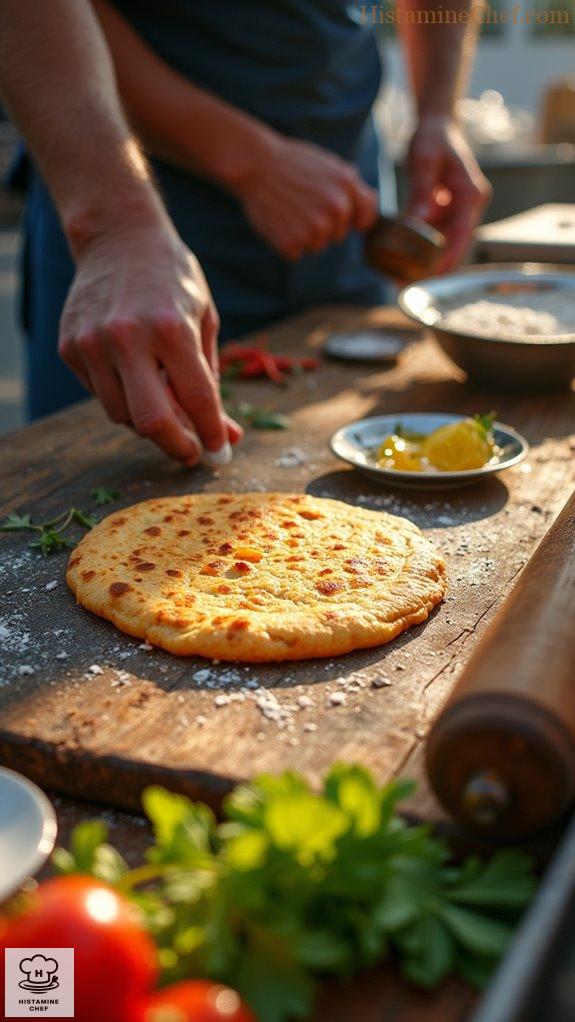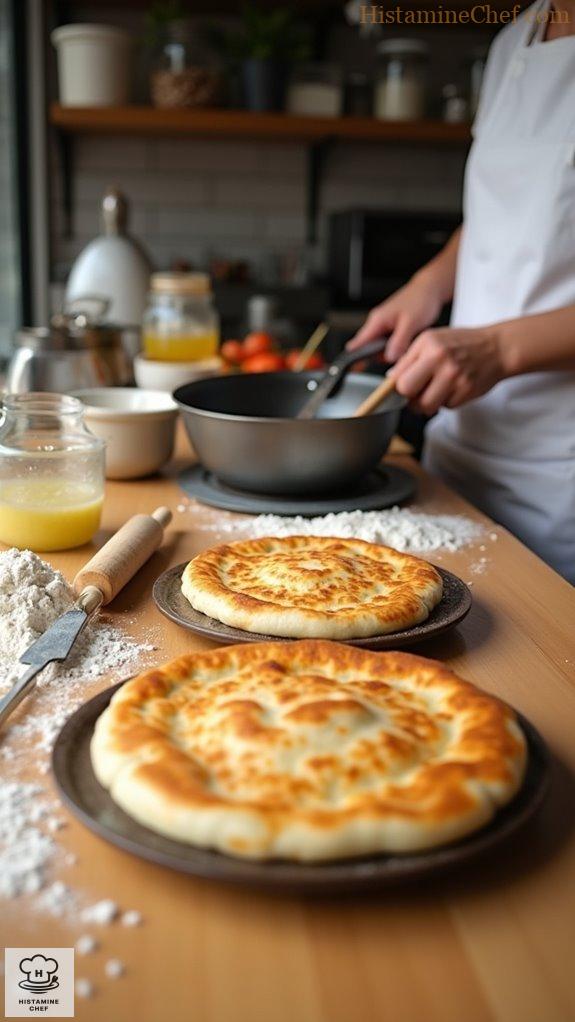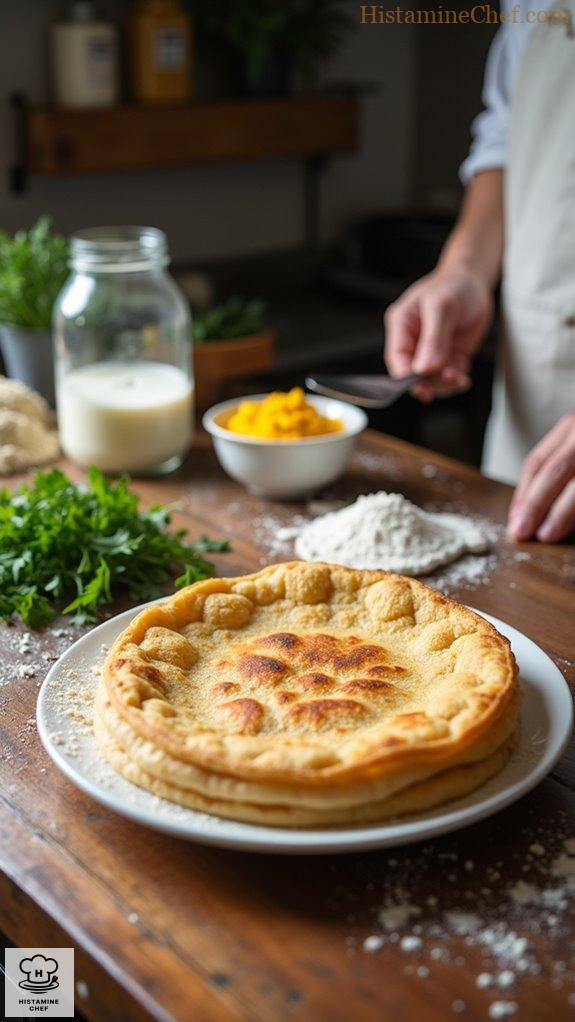Have you ever craved that blissfully flaky Roti Canai but worried about histamine? Well, I’ve got a solution! By swapping regular flour for spelt flour and using coconut oil instead of processed oils, I create a masterpiece that’s not only lower in histamine but incredibly delicious! Just knead, rest, and flip those dough balls until they’re golden brown and tempting. Trust me, you won’t believe how easy and satisfying it is to whip up this street-style delight at home. Ready for a tasty twist?
Vibrant Street Food Scene

Street food culture is a vibrant and integral part of the culinary environment in many countries, connecting locals and visitors alike through the shared joy of eating. In places like Malaysia, street food isn’t just about convenience; it’s a tradition deeply rooted in history.
Street vendors began popping up in the 19th century, providing affordable meals to those working in bustling markets and busy streets. Roti Canai, with its flaky exterior and soft interior, exemplifies this tradition. Originally influenced by Indian cuisine, it has evolved over time, with each vendor adding their unique twist, making it a beloved dish.
The act of cooking and enjoying street food fosters a sense of community, drawing people together around sizzling woks and busy stalls. Even today, shops and food carts, often lined up side by side, showcase the diversity of flavors and techniques that define the local street food scene.
This ongoing love affair with street food not only preserves culinary heritage but also stimulates the local economy, making it an essential part of the culture and identity in many regions.
Flipped With Expert Precision

Street vendors expertly cook Roti Canai on the streets by first preparing a soft dough consisting of flour, water, and a touch of oil. They allow the dough to rest, which helps in making it pliable.
Once rested, the vendor skillfully stretches and flips the dough, creating thin layers that can be seen through. They then fold and place the formed roti on a hot, greased griddle, where it sizzles to perfection, developing a crispy outer layer while remaining flaky inside.
Once golden brown, the roti is expertly flipped to achieve an even cook. Finally, it’s often paired with a variety of flavorful dipping sauces or curry for the ultimate street food experience.
Ingredients:
- 2 cups all-purpose flour
- ½ teaspoon salt
- 1 tablespoon sugar
- 1 tablespoon oil (coconut or olive)
- ¾ cup warm water
- Ghee or additional oil for cooking
- Dipping sauce or curry of choice
- Optional: finely chopped herbs for garnish
Cooking Steps:
- Combine flour, salt, and sugar.
- Gradually add warm water and oil.
- Knead until the dough is smooth.
- Let the dough rest for 30 minutes.
- Divide dough into equal portions.
- Stretch each portion into a thin layer.
- Heat ghee on a griddle.
- Cook roti until golden brown, flip.
Prepare Dough With Spelt Flour

To prepare Street Style Roti Canai at home, start by mixing spelt flour with water, salt, and a dash of coconut oil to create a soft dough.
Knead it well and let it rest covered for at least 30 minutes.
Divide the dough into small balls, then flatten each one and stretch it thinly, ideally using your hands.
Heat a non-stick pan and cook each roti on medium heat until golden brown and flaky, flipping until both sides are perfect.
Serve warm with your favorite dipping sauce or curry.
For extra crispiness, brush with more coconut oil before serving.
Cooking Steps/Ingredients Changed at Home:
- Substitute with spelt flour
- Use coconut oil for flavor
- Rest dough for 30 minutes
- Flatten and stretch by hand
- Cook on non-stick pan
- Serve with preferred dipping sauce
- Brush with coconut oil for crispiness
Low Histamine Variation of Roti Canai

Street food often contains high-histamine ingredients and additives, making it challenging for those with histamine intolerance.
Street food items are typically prepared in large batches and can include preservatives or fermented products that heighten histamine levels. This means individuals may experience adverse reactions when consuming these popular dishes.
Eating street food like Roti Canai can be problematic for individuals with histamine intolerance due to the use of ingredients such as processed oils and spices, which are often restricted per the SIGHI list. Fermented foods, in particular, tend to elevate histamine levels significantly, making them a common concern.
Moreover, many street vendors may use pre-prepared sauces or seasonings that contain high-histamine components. Even subtle flavors from ingredients like leavened dough or specific oils may trigger symptoms.
Low Histamine Variation of Roti Canai: Cooking Instructions
- Use fresh ingredients; avoid any pre-packaged or processed foods.
- Substitute white flour with millet flour or rice flour for the dough.
- Use coconut oil instead of sunflower oil for frying.
- Replace any seasoning with fresh herbs like parsley or chives.
- Avoid leavening agents; prepare flatbread without yeast or dairy.
- Prepare dough fresh each time; avoid refrigerated or stored dough.
- Cook the Roti Canai on a well-greased pan over low heat.
- Serve with a homemade dip using allowed herbs and fruits, like mango.
- Keep the cooking surface clean and free of any high-histamine residue.
- Enjoy immediately for the best taste and to minimize histamine buildup.
Additionally, fresh ingredients are essential for minimizing histamine levels in your meals.
Video Summary
Roti Canai, a popular flatbread from Malaysia, owes its origins to Indian Muslim cuisine. In this video, we’ll explore the authentic street version of Roti Canai and then adapt it for a low histamine home version.
Street vendors start by mixing 500 grams of all-purpose flour with 2 teaspoons of salt in a large mixing bowl. They then create a well in the flour and pour in 200 milliliters of warm water along with 1 tablespoon of sugar. The mixture is kneaded by hand until a smooth dough forms.
Next, the dough rests for at least 2 hours. After resting, the vendors divide the dough into small balls and flatten them with their palms. Each piece is stretched into a thin layer before being folded into a square. The folded dough is cooked on a hot griddle with 2 tablespoons of ghee until golden brown and crispy on both sides.
For the home low histamine version, change all-purpose flour to spelt flour. Use only 200 milliliters of water without added sugar. Knead the spelt flour until smooth, allowing it to rest for 2 hours. Shape the dough into small balls and guarantee they’re thicker for cooking. Instead of ghee, use coconut oil for frying.
Cook the flattened pieces on a skillet and press down gently to achieve a crispy texture. This version will be lighter in taste and more suitable for sensitive diets.
When presented, the final meal looks golden brown and flaky, with enticing, airy layers. Click the link in the description for the full recipe!


Leave a Reply